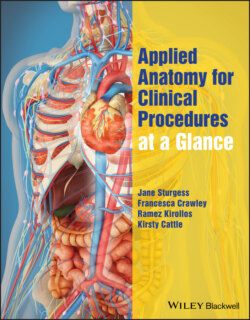Applied Anatomy for Clinical Procedures at a Glance

Реклама. ООО «ЛитРес», ИНН: 7719571260.
Оглавление
Jane Sturgess. Applied Anatomy for Clinical Procedures at a Glance
Table of Contents
List of Illustrations
Guide
Pages
Applied Anatomy for Clinical Procedures at a Glance
Contributors
1 Scrubbing up
Equipment (Figure 1.1)
Antiseptic solutions
Procedure (Figure 1.4)
2 Setting up a sterile field and draping the patient
Equipment (Figure 2.1)
Procedure
Top tips
3 Three‐way tap
Description of the three‐way tap
Potential uses of the three‐way tap (Figure 3.3)
Safe use of a three‐way tap
After the procedure
Anatomical pitfalls
Top tips
4 Common equipment for core clinical procedures
Needles
Hollow needles
Butterflies
Spinal needles (Figure 4.3)
Cannulas (Figure 4.4)
Syringes (Figure 4.5)
Sampling devices. Urinary catheters (Figure 4.6)
Catheter bags (Figure 4.7)
Commonly used blood bottles (Figures 4.8 and 4.9)
Sample pots (Figure 4.10)
Sterile procedure packs (Figures 4.11 and 4.12)
5 Local anaesthetic infiltration
Classes of local anaesthetics (Figure 5.1)
Mechanism of action
Dose
Side effects
Technique
Anatomical pitfalls
Top tips
6 Obtaining consent
Why do we obtain consent?
Principles of obtaining consent if the patient has capacity
Principles of obtaining consent if the patient does not have capacity
Obtaining consent
Responsibility for obtaining consent
Discussing side effects/risk
Verbal or written consent? (Figures 6.2 and 6.3)
Consent in children
7 Manometer for central venous pressure and lumbar puncture
What is a manometer line?
What is normal pressure?
Set‐up of the CSF manometer line. Equipment (Figure 7.4)
Technique
Set‐up of the CVP manometer line. Equipment (Figure 7.5)
Technique
Common anatomical pitfalls. CSF
CVP
8 Bladder irrigation sets
Equipment
Set‐up
Common anatomical pitfalls
Top tips
9 Underwater seal for chest drains
Equipment (Figure 9.1)
Connection (Figures 9.3 and 9.4)
How does it work? (see Figure 9.2)
Anatomical pitfalls
Top tips
10 Male catheterisation
Equipment (Figure 10.1)
Procedure
Contraindications
Common problems
11 Female catheterisation
Indications
Equipment (Figure 11.1)
Pre‐procedure
Procedure
Top tips
12 Arterial blood gases
Equipment (Figure 12.1)
Procedure. Identify patient and assemble equipment
Perform procedure
Post‐procedure
Allen’s test (Figure 12.3)
Brachial and femoral stabs
Common anatomical pitfalls
Top tips
13 Performing an electrocardiogram
Equipment (Figure 13.1)
Procedure
Anatomical (and other) pitfalls
Top tips
14 Oropharyngeal airway
Equipment (Figure 14.1)
Technique (Figure 14.2)
Aftercare
Common anatomical pitfalls
Top tips
15 Nasopharyngeal airway
Equipment (Figure 15.1)
Technique (Figure 15.2)
Aftercare
Common anatomical pitfalls
Top tips
16 Laryngeal mask airway
Equipment
Technique
Aftercare
Common anatomical pitfalls
Top tips
17 Central venous cannulation (high approach internal jugular)
How to insert a central venous line
Equipment (Figure 17.1)
Technique (Figure 17.3)
Landmarks for internal jugular vein (Figure 17.4)
Aftercare
Common complications
18 Central venous cannulation (low approach internal jugular)
How to insert a central venous line
Equipment (Figure 18.1)
Technique (Figure 18.3)
Landmarks for internal jugular vein (Figure 18.4)
Aftercare
Common complications
19 Central venous cannulation (subclavian)
How to insert a central venous line
Equipment (Figure 19.1)
Technique (Figure 19.3)
Aftercare
Common complications
Landmarks for subclavian vein (Figure 19.4)
Top tips
20 Direct current cardioversion
Indications
Equipment (Figure 20.1)
Contraindications
Pre‐procedure
Procedure
Post‐procedure
Top tip
Pitfalls
21 Intercostal drains
Requirements
Equipment (Figure 21.1)
Procedure – Seldinger technique
Procedure – Surgical technique
Anatomical (and other) pitfalls
22 Pleural tap
Requirements
Equipment (Figure 22.1)
Procedure
Anatomical (and other) pitfalls
Complications
23 Inserting a nasogastric tube
Equipment (Figure 23.1)
Procedure
Post‐procedure
Contraindications to NGT insertion
Pitfalls
Top tips
24 Lumbar puncture
Equipment (Figure 24.1)
Technique
Aftercare
Common anatomical pitfalls. Bone only
Bloody tap
CSF flow stops
Obesity – unable to identify midline or spinous process
Top tips. Position
Insertion angle
Depth of dura
Preparation
Position
25 Bone marrow aspirate
Equipment (Figure 25.1)
Pre‐procedure
Procedure
Clotting requirements for a bone marrow aspirate
26 Ascitic tap
Equipment (Figure 26.1)
Contraindications
Pre‐procedure
Procedure
Post‐procedure
Top tips
27 Paracentesis
Indications
Equipment (Figure 27.1)
Pre‐procedure
Procedure
Post‐procedure
Complications
28 Knee aspiration
Equipment (Figure 28.1)
Indications
Procedure
Aftercare
Common anatomical pitfalls (Figure 28.3)
Anatomical top tips
29 Skin biopsy
Equipment (Figure 29.1)
Indications
Procedure
Anatomical pitfalls
Top tips
30 Basic suturing
Equipment (Figure 30.1)
Choice of suture
Factors determining the choice of sutures and needles
Technique. General principles
Variations in suturing techniques
Removal of sutures
Anatomical pitfalls
31 Basic anastomotic techniques
Equipment (Figure 31.1a–c)
Technique
Types (Figure 31.2)
Anatomical pitfalls: Bowel
Anatomical pitfalls: Vascular
Aftercare: Bowel
Aftercare: Vascular
32 Abscess drainage and debridement
Equipment (Figure 32.1)
Procedure (Figure 32.2)
Aftercare
Pitfalls
Anatomical top tips
33 Bag mask ventilation (adults)
Equipment (Figure 33.1)
Technique (Figure 33.2)
Aftercare
Common anatomical pitfalls
Top tips
34 Endotracheal intubation (adults)
Equipment (Figure 34.1)
Technique
Aftercare
Common anatomical pitfalls
Top tips
35 Needle cricothryoidotomy (adults)
Equipment (Figure 35.1)
Technique
Aftercare
Common anatomical pitfalls
Top tips
36 Surgical cricothyroidotomy
Equipment
Indications
Contraindications
Procedure (Figure 36.2)
Aftercare
Common anatomical pitfalls
Top tip
37 Defibrillation
Equipment (Figure 37.1)
Technique
Aftercare
Common anatomical pitfalls
Top tips
38 Spinal injection
Equipment (Figure 38.1)
Technique
Aftercare
Common anatomical pitfalls
Top tips
Difficulty aspirating CSF
Safety (Figure 38.5)
39 Epidural injection
Equipment (Figure 39.1)
Technique
Aftercare
Common anatomical pitfalls
Top tips
40 Procedure‐related safety
The problem
Definitions (as per the World Health Organisation)
The response
Responsibilities for National Health Service (NHS) and staff
Top tips (from the World Health Organisation)
References
Additional reading
Index
WILEY END USER LICENSE AGREEMENT
Отрывок из книги
Jane Sturgess
Francesca Crawley
.....
Chlorhexidine: This is a cationic polybiguanide which achieves both a bacteriostatic and bactericidal effect depending on its concentration, through the release of charged cations which bind to and disrupt the bacterial cell wall. This solution is effective against a broad range of organisms, including gram‐positive and gram‐negative organisms, aerobes, anaerobes, and yeasts.
Povidone iodine: This is a solution containing a combination of iodine and polyvinylpyrrolidone (PVP). A bactericidal effect is achieved through the molecular iodine, and PVP acts as an iodophor to prevent irritation and toxicity to the tissue by keeping the free iodine concentration low. The solution acts against gram‐positive and gram‐negative bacteria, bacterial spores, viruses, protozoa, and fungi.
.....